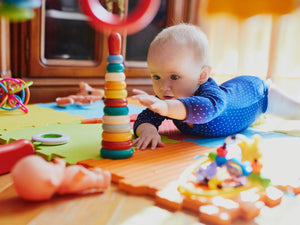Your Baby’s Development Milestones 4-8 Months
As they reach the middle of their first year, you'll start to see bigger leaps in their growth and ability!
In this article, we’re going to discuss your baby’s developmental milestones between 4-8 months, and what you can expect along the way.
Keep in mind that these milestones are just a guide. Every baby has their own “normal” development pace. Check with your GP or child health nurse if you are concerned about your baby’s growth and development.
Key Takeaways:
- Developmental milestones for babies aged 4-8 months include progress in gross motor skills, fine motor and cognitive skills, social and emotional development, communication abilities, and sleep routines.
- Physical milestones like rolling over, sitting up, and crawling develop rapidly, with safety-proofing the home becoming essential as mobility increases.
- Social and emotional skills grow through interactions, with babies beginning to express emotions, develop empathy, and experience separation anxiety around 7 months.
- Improving communication skills involves engaging with your baby by speaking, playing, and mimicking sounds, which helps them learn to babble and imitate speech.
What Counts as a Developmental Milestone
We group developmental milestones into distinct categories. These cover physical growth, as well as the changes to your baby’s brain and skills:
- Gross motor skills include full-body movements and movements that use large muscle groups. This includes rolling over, sitting up and learning to stand.
- Fine motor and cognitive skills are precise muscle movements involving the hands, fingers, feet and toes. This includes grasping objects and intentionally looking at or following objects with their eyes.
- Social and emotional skills cover how your baby interacts with other people and regulates their own emotions. This includes recognising faces, building bonds with others, self-soothing and reacting to touch.
- Communication skills refer to your baby’s verbal communication. This includes crying, grunting, babbling, laughing and forming the sounds of speech.
- Vision development is your baby’s visual development. As your baby grows, they learn to recognise faces and specific objects, such as toys, books and moving images on a screen.
- Hearing development includes your baby’s ability to hear and imitate sounds. Hearing development plays a strong role in speech development and communication skills.

Your Baby’s Development Milestones 4-8 Months
Babies grow quickly and absorb everything around them. The best thing you can do for your baby’s development is to spend time together, play, read books and speak to them.
Gross Motor Skills
- At 4 months, some babies learn to roll over. Others will start learning the movements needed to roll over. It’s important to transition your baby to an arms free, age-appropriate sleeping bag if you notice them attempting to roll.
- Between 5-7 months babies learn to roll over freely in both directions. They’ll soon be able to sit up on their own, and sit without support. They will drag themselves forward and push themselves backwards when they’re on the floor.
- After 8 months, you can expect your baby to learn how to move from a seated position onto their hands and knees. Some babies may learn how to crawl or shuffle around the floor, or pull themself into a standing position.
Your baby will learn how to move around the house very quickly at this point. Once they learn how to roll over freely and support themselves during tummy time, they will start testing their ability to shuffle, crawl and even stand.
As your baby gets more mobile, it’s important to make your house safe. Consider covering the sharp edges of furniture, install blanking plates in power outlets, and add latches to cabinet doors.
You can encourage your baby’s physical development with plenty of play and tummy time, and by allowing them to explore their new abilities in a safe environment.
Fine Motor and Cognitive Skills
- At 4 months, your baby’s curiosity grows. They learn to focus on objects and start linking things they can see with their sense of taste, touch and hearing.
- Between 5-7 months they learn to grasp and pick up objects. They learn to pass objects from one hand to another, and often like to bang things together. As your baby interacts with their surroundings, their memory also improves and they’ll be able to search for dropped objects.
- After 8 months, your baby will have a good memory for dropped toys. They’ll look for specific objects, and may be able to point at things with a finger. Their vision is also well-developed, so they can see you from across the room.
This is the age where your baby really begins to interact with their world. They’ll take more interest in exploration and toys. Your baby will get better at picking up objects, and they’re likely to put things straight into their mouths!
Putting things in their mouths is a sign that your baby is getting ready for solid food. They’ll also take an interest in the foods you’re eating. It’s recommended that you start feeding your baby solids at around 6 months old.

Social and Emotional Skills
- At 4 months, babies start displaying more emotions, like frustration and anger. But they also communicate better and enjoy face-to-face play with adults they recognise.
- Between 5-7 months, your baby will take a real interest in playing and interacting with other children. They will smile and laugh with you, and begin “talking” to you through gurgling and babbling.
- After 8 months you’ll see your baby’s full personality come out. They learn to interact with adults and other children, play, “talk” to you and more. Their empathy also develops, and they may cry when they hear another baby crying.
This is the age where your baby will learn to engage socially. They’ll smile, laugh, play and “talk” with you.
At 4 months, you can expect your baby to develop body language, and use their arms, legs and other movements to show you how they’re feeling.
Beyond 5 months, babies will learn to show you what they need. For instance, they may look at an adult and raise their arms when they want to be picked up.
Your baby may also start to experience separation anxiety at 7 months. This will fade with age, but you can expect them to whinge or cry when you leave the room. Spending time apart and encouraging your baby to build a bond with other adults can reduce the symptoms of separation anxiety.
The more their social skills grow, the more your baby will want to interact with you. The best thing you can do to improve social and emotional skills is to interact, play and talk to your little one.
Communication Skills
- At 4 months, babies smile and laugh freely, and they start using their body to show emotions by flapping their arms or kicking their legs. They’ll also engage with you more, and take an interest when you speak to them.
- Between 5-7 months, your baby will start to “talk” to you. They may make chattering or babbling sounds, and they can even imitate the sounds of speech by saying things like “mamama” or “dadada”.
- After 8 months, your baby’s communication skills grow every day. They’ll imitate more sounds of speech, and engage with you directly. If you’re reading them a story, they may point at objects and try to turn the pages.
Babies learn to communicate by absorbing everything around them. Between 4-8 months, they’ll watch and listen, and begin imitating those things on their own.
While your baby can’t truly speak at this age, they imitate the sounds of speech and can make repetitive sounds like “mama” or “dada”.
As they learn to communicate better, they will use other signals to show you when they’re tired, hungry or experiencing another emotion. That can make it easier to figure out what your baby wants.
The best ways to improve your baby’s communication skills are to interact, play and speak with them. Copy the sounds they make, and then change the sound to something slightly different to encourage them to make new sounds.
You should also share your baby’s attention. Follow their head and eyeline and engage with the things they’re looking at. Sharing their attention is a good way to build communication skills and teach them how to interact with others.
Baby Sleep Routines 4-8 Months
Sleep and settling get easier between 4-8 months as your baby learns to self-soothe. The amount of time your baby spends crying should start to settle, but they can still be upset or fussy when tired, hungry or frustrated.
Between 4-6 months, you can expect your baby to sleep for 2-3 hours at a time. They’ll need a total of 10-18 hours sleep in a 24-hour period.
Beyond 6 months, they’ll start to sleep in longer bursts of 6-12 hours, and they’ll only need 10-14 hours of sleep in a 24-hour period.
This is also the age where your baby learns to sleep through the night. As their circadian rhythm develops further, their sleep patterns will start to match yours, so you can rest a little easier.
See our complete article on your baby’s first year sleep routine to learn more about sleep and tips on settling your baby.
Learn About Your Baby’s Development With Nourish Baby!
Watching your little one change from a squishy bundle into a mini human is one of the most exciting things you’ll ever do. They develop fast between 4-8 months, and you’ll see them learning new skills every day.
If you want to know more about baby development and how you can encourage their growth, Nourish Baby can help.
Nourish Baby offers antenatal education that cover pregnancy, labour, birth and early childhood. Our courses provide great information on developmental milestones and what you can expect in their first few years of life.
You can download our courses online now, or speak with our team to learn more about your baby’s growth!
Our Products
-

01. Guide to a Healthy Pregnancy
$55 -

02. Positive Birthing Course
$55 -

03. Infant Feeding Guide
$55 -

04. Baby Sleep Guide - First 12 Months
$55 -

05. Toddler Parenting Course 1 - 3 Years
$55
-
 When to Start Antenatal Classes?
When to Start Antenatal Classes?
Becoming a parent is an incredible milestone, but it comes with a host of changes that can be daunting, especially for first time parents. Antenatal classes are all about offering expectant parents the education they need to make informed decisions, look after their bodies and care for their newborn babies. While you probably already have a long list of things you need to accomplish during your pregnancy, it’s a good idea to make time to attend antenatal classes.
-
 Development Milestones 4-8 Months
Development Milestones 4-8 Months
As they reach the middle of their first year, you'll start to see bigger leaps in their growth and ability!
In this article, we’re going to discuss your baby’s developmental milestones between 4-8 months, and what you can expect along the way.






 When to Start Antenatal Classes?
When to Start Antenatal Classes?
 Development Milestones 4-8 Months
Development Milestones 4-8 Months








